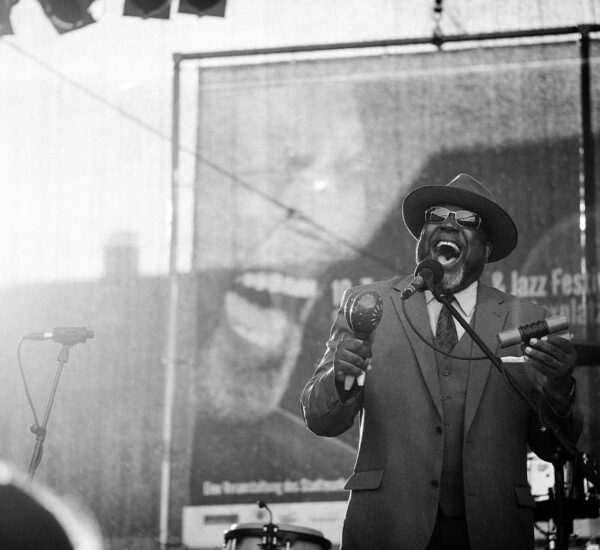New York, Radio City Music Hall, February 1998. The 40th anniversary of the Grammy Awards was one of the most eventful music shows of the year.
As Best Album of the Year author Bob Dylan was performing his song “Love Sick,” a man burst onto the stage with “soy bomb” written on his chest. The confusion he caused, however, could not obscure the greatness of the music that night.
That same night, The Smashing Pumpkins for “The End Is the Beginning Is the End”, Fiona Apple for “Criminal” and The Wallflowers for “One Headlight” received their well-deserved awards.
The same ceremony later featured a long undeservedly overshadowed musician, Taj Mahal, who finally managed to break the long-awaited ovation. He was 55 years old at the time, and this was his first Grammy.
His album “Senor Blues” won first place for Best Contemporary Blues Album. An unforgettable moment for a man who has dedicated his life to working with the blues sound and creating several new blues styles. Especially when you consider how much and how long he was criticized for his musical experiments.
Chances are you have a question like this, “What’s a bluesman article doing on a rock music website?” The answer is simple – at one time, Taj Mahal was a musician who played not only blues, but also rock and roll. In addition, he was friends and communicated a lot with famous rock musicians (you will see their names while reading the article). Not many people have heard of him in our area and I sincerely think, that it is unfair. Anyway, read on and you will understand!
Taj Mahal and the musicians of the rock scene
He was never your average bluesman. He grew up in Harlem, in a family with Caribbean roots. He got to the heart of the blues in the ’60s, and then started digging even deeper and pulling out the hidden connections that connected Afro-Caribbean folk, rhythm and blues, gospel, African and Latin American music.
One-third tradition keeper and two-thirds experimenter, Mahal may be the first American musician to play ethnic music before the term itself existed.
One of the first to become interested in the new sound was Eric Clapton. In his autobiography he writes that he accepted Mick Jagger’s invitation to participate in his show “The Rolling Stones Rock & Roll Circus” in 1968 (as part of the supergroup The Dirty Mac) mainly because he wanted to meet Mahal.
Keith Richards, who had previously performed with Mahal and Graham Parsons in Los Angeles, admitted that Taj showed him some new tricks, adding that: “His arsenal was to be envied, it always was.”
At this concert, Taj Mahal was the musician solely representing the black American blues, music the Stones adored. This show was filmed, and the material was to be made into a musical film.
There was footage of Taj Mahal, the musician with a badass outfit: a wide-brimmed hat, a red scarf around his neck, a smart leather jacket. He looked just as good as the other stars invited to the show – Clapton, Lennon, and many others. That’s how he was – the hippest of the hippies.
His early years and his fascination with the blues
Henry St. Clair Fredericke (that was his real name) was born in 1942 in Harlem, New York, and soon after his family moved to Springfield, Massachusetts.
The life of his parents was closely connected with music: his mother sang in the church choir, and his father was quite a famous jazz pianist and arranger. Henry Jr. was raised on the songs of Charles Mingus and Thelonious Monk. But his greatest inspiration was the traditional culture of his family.
My grandparents emigrated to the U.S. and my mother’s family moved from South Carolina to New York,” Mahal explains. – My parents talked about it a lot, and I understood a lot about Africa and the British Empire.
When I heard music, I could understand where it came from. I was interested in any music with a blues (or blues-like) sound. It didn’t matter if it was country or classical. When I got a whiff of the blues, my spirit made a stand. I wanted to play what I heard myself. It was kind of like the sound of an ancestral voice.
Beginning to play guitar as a teenager, Taj combined his passion for music with attending agricultural college, but in the end, the blues won out. One of the most powerful tragic experiences that influenced Taj and his relationship to music was the death of his father – it was an accident on the construction site where he worked.
First Steps: Taj Mahal as a rhythm and blues musician
The future musician changed his name to Taj Mahal while at university (it came to him in a dream). There he led his first rhythm and blues band, The Elektras. In 1964, Taj and his friend Jesse Lee Kincaid traveled to California to conquer the fertile Los Angeles music scene.
There they met young guitarist Ray Cooder, just like them, a true fan of folk and blues. Like Taj Mahal, Cooder was fascinated by the rich possibilities of “roots music.” Having bonded over this after playing a concert together on Sunset Boulevard, they decided it was time for the next logical step: forming a band.
The newly formed The Rising Sons consisted of Taj Mahal, Ry Cooder, Jessie Lee Kincaid, bassist Gary Marker and future Spirit drummer Ed Cassidy (later replaced by Kevin Kelly).
With Kincaid and Mahal on vocals, they managed to win the hearts of the West Coast with new readings of old blues compositions by Skip James, Charlie Patton and Slippery John Estes as well as their own creations.
They played opening for Otis Redding and The Temptations, and Taj Mahal gradually began to mingle on equal footing with such “superheroes” as Howlin’ Wolfe, Muddy Waters and Lightnin’ Hopkins.
Columbia suggested they record a studio album with producer Terry Melcher, who had just successfully completed an album with The Byrds.
But it never came to fruition.
The album was never released, and the band broke up in 1966. Despite the fact that The Rising Sons paved the way for such blues icons as The Grateful Dead and Moby Grape, all their recorded legacy was just one 45, containing two songs: the rock’n’roll “Candy Man” and the bluesy “The Devil’s Got My Woman”. The full-length album didn’t see the light of day until 26 years later.
Columbia knew they were dealing with up-and-coming musicians, though – Taj Mahal recorded a striking solo debut album in 1968, in which he shook off the dust of good old blues such as “Statesboro Blues,” “Leaving Trunk” and “Everybody’s Got To Change Sometime.”
Kuder also took part in the recording of this album, but most interesting was the musical dialogue between Mahal and the second guitarist, Jesse Ed Davis. Mahal was an outstanding slide guitarist.
Besides guitar, he played harmonica and sang – the warm crackle of his voice gave his songs a special, slightly bouncing sound. The craftsmanship of the recording, unfortunately, did not match the sales of the album, but Mahal’s colleagues appreciated it.
The Rolling Stones Rock And Roll Circus show was conceived as a televised presentation of the just-released Beggar’s Banquet album.
Taj Mahal and his band played four songs that were supposed to be their British breakthrough. But it wasn’t meant to be. The Stones were unhappy with their own performance, not incendiary enough in their opinion, and decided not to give the tape to television.
Taj Mahal, as a musician in need of promotion, may have missed his chance then, but he nevertheless has the most wonderful memories of the trip.
Taj’s long struggle for recognition
Back in the States, Mahal quickly and easily recorded his next album, The Natch’l Blues, which expanded his musical palette by including two soul covers on the record. Pianist Al Cooper and former Little Richard drummer Earl Palmer contributed to the record.
In 1969, the semi-acoustic double-play Giant Step/De Ole Folks At Home was released – it was Mahal’s first album to reach Billboard magazine’s top 100. Yet Taj Mahal was a consistently obscure musician, unlike Frank Zappa and Led Zeppelin, who were in the top 100.
Mahal moved to San Francisco, which benefited his work:
The musicians there are very picky – they won’t play with the first person they meet,” he recalls. – And the promoters are like that. I was lucky and people really liked my music. Our name is on a lot of posters at the Fillmore concert hall. We once played on the same stage as Led Zeppelin [in the fall of 1969].
Mahal continued to ride the waves of music freely. In 1971 he recorded an album of West Indian calypso songs, Happy Just To Be Like I Am, and in 1974 Mo’Roots came out – the result of exploring the links between blues and Jamaican reggae. One of the guest musicians was The Wailers bassist Aston Barrett, and he played a cover of one of the songs by his own band Slave Driver.
But Mahal’s pluralism was not to everyone’s liking. Record sales were far from what they should have been, and he stopped working with Columbia and signed with Warner Bros. in 1976.
The three subsequent albums recorded with the new label did not change the situation.
By the end of the ’70s he was out of contract. “I would have loved to do just blues and R&B – writing my own songs and interpreting existing ones,” he explains. – But nobody wanted to work with me.”
Taj Mahal then moved to Hawaii and began recording albums for kids.
The next album (“Taj,” 1987) didn’t come out until a decade later. But he didn’t fully resume his relationship with the music industry until the early ’90s.
Success at last.
Mahal found a home on a new label, Private Music, co-founded by former Tangerine Dream member Peter Bauman. This allowed him to rediscover his unique blues groove – the Phantom Blues album (featuring Eric Clapton and Bonnie Raitt) was released in 1996.
His third release on that label, Senor Blues, won him a Grammy (“The main achievement was that now people had to listen to that album,” he says).
Another Grammy went to his live album, Shoutin’ in Key.
But that was far from the pinnacle of his fame. Taj Mahal received wider recognition as a versatile musician in 1999 when his CD “Kulanjan” was released – a collaboration with the Malian musician Toumani Diabate, who played a folk instrument – kora.
Here Taj was a true innovator in the field of music, crossing West African melodies with primitive blues.
“I really wanted people to hear this music,” says Mahal, “Kulanjan allowed me to go back in time and hear the voices of my ancestors. After recording the album, I felt I could no longer play guitar. I could keep just my bark and that would be more than enough for me.


